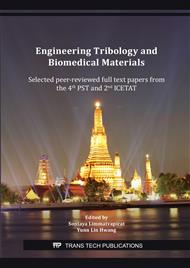p.153
p.164
p.170
p.176
p.182
p.187
p.193
p.199
p.208
Friction, Scuffing and Transfer Layer Formation in Lubricated Sliding of EN31 Steel and Tungsten Carbide (WC): Surface Topography Effects
Abstract:
Surface topographies play a critical role in controlling friction, surface damage and transfer layer formation in engineering applications; hence understanding this is of great importance. In this work, experimental studies were carried out to understand the influence of surface topography on friction, scuffing and transfer layer formation in completely immersed lubricated sliding interactions. For this, sliding experiments were carried out in sphere on flat configuration using EN31 steel flats and Tungsten Carbide pin countersurface. Perpendicular and parallel surface topographies were induced onto the steel flats. Experiments were conducted at high normal loads of 1000N, 2000N and 3000N. The results show that Surface topography has a significant influence on the frictional response. When the topography directionality was perpendicular to the sliding direction, scuffing was observed only at a high load of 3000N. A ‘peak friction’ was also observed during the occurrence of scuffing. When the directionality in topography was parallel to sliding direction, scuffing and surface damage occurred from 2000N itself, accompanied by a high amount of transfer layer formation. This can be attributed to the directionality of parallel topography, which displaces away the lubricant during sliding interaction, creating metal-to-metal contact and hence leading to scuffing and higher transfer layer formation.
Info:
Periodical:
Pages:
182-186
Citation:
Online since:
October 2021
Authors:
Keywords:
Price:
Сopyright:
© 2021 Trans Tech Publications Ltd. All Rights Reserved
Share:
Citation:


